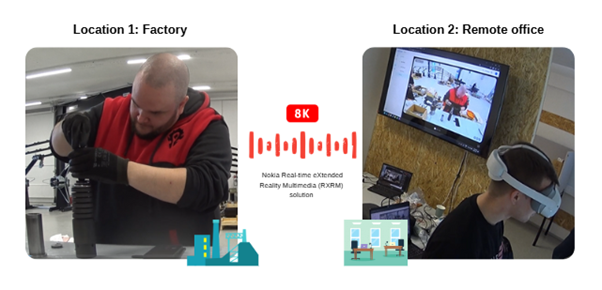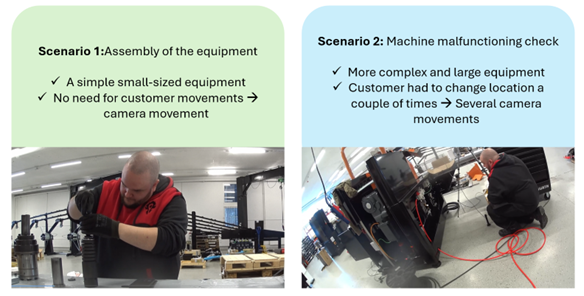Next-Generation Customer Support: How 360 Video Streaming Can Enhance Industrial Operations – A Case Study by Tampere University & Vaski Oy
Industrial customer support faces many challenges, including communication and language barriers, inefficient guidance processes, misunderstandings, faulty actions in installation and inspections, which in turn may lead to costly delays and additional struggles. Overall, providing support over a voice call is a tedious task, prone to errors and full of stressful moments.
How innovative technologies can solve the issues mentioned above?
In this research case, performed in collaboration between Vaski and Tampere University (TAU) as a part of Industry X project, we explored the potential of 360-degree video streaming to find solutions to above-mentioned struggles and thus advance the efficiency and quality of customer support operations. Central to our research was Nokia RXRM technology, an advanced streaming platform that ensures real-time, high-resolution and low-latency video transmission, making it ideal for remote troubleshooting and real-time assistance.

The primary objectives of our study were:
To test 360 live video streaming using Nokia RXRM technology in real-world industrial settings.
To evaluate its impact on the quality and efficiency of customer support and operational improvements based on the involvement of domain experts.
To compare the elements of user experience when watching a 360 stream via head-mounted displays (HMDs) versus a large screen.
Two test scenarios were designed to evaluate the impact of 360 streaming. The first scenario involved assembling a small piece of equipment, requiring minimal movement and camera adjustments. The second scenario dealt with diagnosing a machine malfunction, which was more complex and required the customer to change locations, leading to multiple camera adjustments. Five domain experts participated, including installation engineers, supervisors, and product developers, with two playing the roles of the “customer” and the “support” representative.

Key Findings
The study demonstrated that 360 video streaming has potential to improve and optimize customer support and installation processes. Participants reported that the technology streamlined communication, enhanced troubleshooting, and provided greater control over visual guidance. The results showed that different display methods offered distinct advantages, making the technology adaptable for various industrial applications.
· Improved Communication and Clarity – 360 video technology enhanced communication by providing a real-time visual reference. Support staff could watch the customer and quickly identify issues, reducing misunderstandings and the need for repeated explanations. From the other side, clearer instructions enabled customers to follow tasks more efficiently, improving overall service quality and reducing frustration.
· Instant Feedback for Effective Guidance – The ability to provide instant feedback proved to be a significant advantage. Support personnel could immediately detect and correct errors, minimizing downtime and increasing efficiency. This capability also allowed for better collaboration between teams.
· HMDs vs. Large Screens: Different Benefits for Different Tasks – Both viewing methods had their advantages. Large screens allowed for quicker instructions and were better suited for task-focused guidance, while HMDs provided an immersive, holistic understanding of the workspace. However, large screens were more ergonomic for extended support sessions, making them the preferred option for prolonged use.
· Greater Control and Flexibility Over Viewing – Unlike traditional video or images, 360 video offered users full control over their viewing perspective. This freedom allowed for more thorough inspections, better context awareness, and an improved ability to focus on specific details. The ability to zoom in (4K resolution) was particularly beneficial for intricate machine inspections.
In summary, compared to traditional voice calls-based support, the usage of 360 video streaming can indeed greatly enhance customer support operations, optimizing the workflow and building a bridge of understanding between customers and support personnel. In comparison to standard video calls or photos, the ability to freely navigate the visual field, zoom in for intricate inspections, and view content on various devices makes it a versatile tool to address the existing challenges in the field.
Challenges in Adoption
However, every novel technology has its own challenges and limiting factors, which should be acknowledged to ensure smooth implementation and adoption. These challenges fall into two main categories: technical and human related.
· Technical Challenges – One of the most significant barriers to widespread adoption is the internet connectivity at industrial sites. Many factories and machine setups still have unreliable or slow internet, which can impact the quality and stability of 360 video streams. Additionally, the complexity of setting up the stream is a concern. Users may struggle with configuring the system properly, making it essential to develop simplified “plug & play” solutions that require minimal technical expertise.
· Human-Related Challenges – The adoption of 360 video streaming also depends on the individuals using it. Factors such as education level, familiarity with technology, and overall attitude toward digital tools influence how easily employees can integrate the system into their workflow. Some users, especially those unfamiliar with gaming or immersive technologies, may find the learning curve steep. Additionally, resistance to technology can hinder adoption, as some employees may be reluctant to change established support methods. High turnover rates and fast-changing personnel further complicate training efforts, as new employees may require frequent onboarding.
Summary
In summary, our research confirmed that 360 video has the potential to transform customer support by streamlining communication, reducing errors, and improving operational efficiency. While challenges exist, the benefits far outweigh the drawbacks. Beyond customer support, the expert insights highlighted that 360 video presents opportunities in other areas: from advancing training methods to enhancing sustainability and reducing travelling. As industries continue to embrace digital transformation, 360 video streaming could become an essential tool in professional support and training environments.